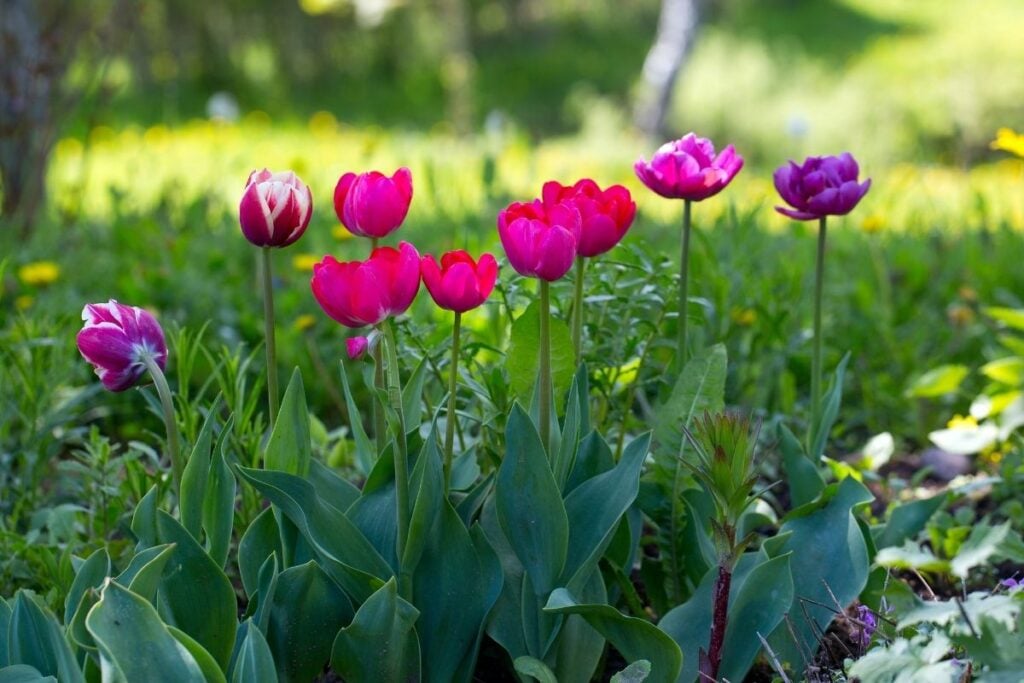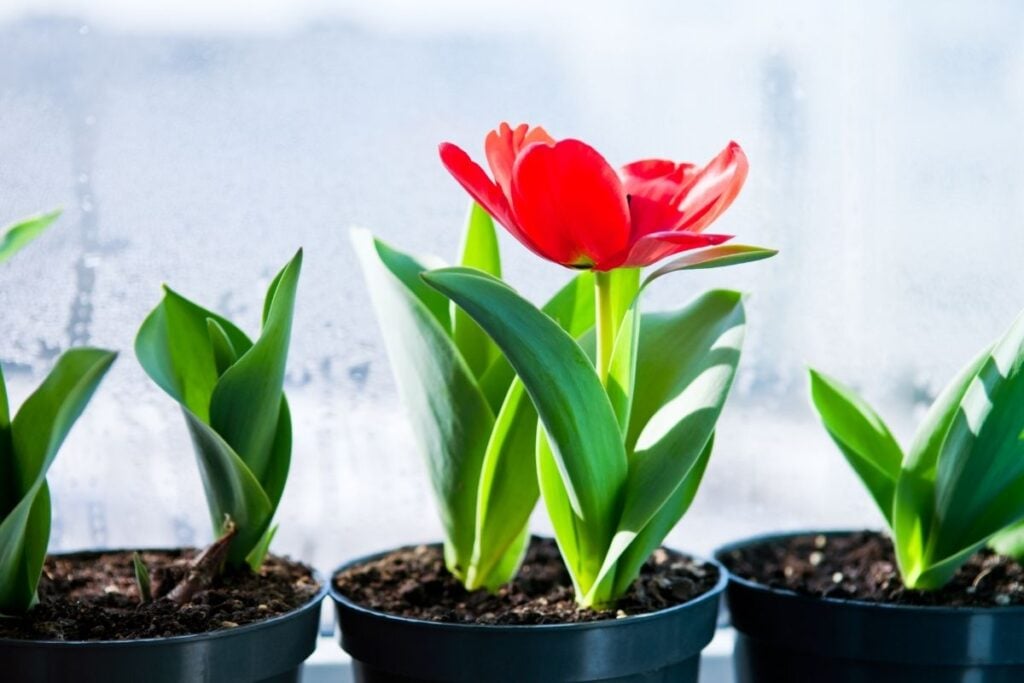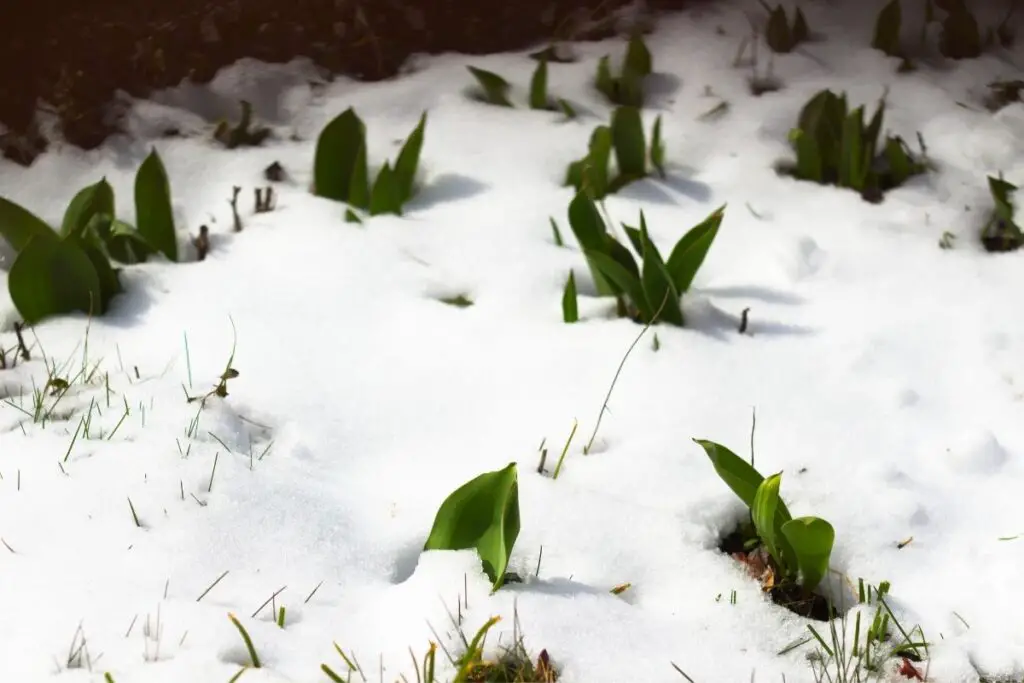Unlike many plants that cannot bear low winter temperatures, the tulip prospers in cold weather. The tulips make their own rules for their growth and flower only when they feel ready. Many gardeners are unaware of the significant impact that temperature conditions and water can have on Tulip’s quality and bloom time.
So, in today’s article, we shall learn what temperature do tulips need.
As a general rule, tulips thrive when grown at a temperature ranging between 30-55°F. If the temperature goes above 55°F, the tulip plant starts drooping, losing its flowers. Although they can handle short cold snaps, but anything below 30°F for a long duration can lead to cold damage.
Thus, we are here to guide you with all the essential information on the temperature needs of tulips to ensure a fantastic planting journey.

The ideal temperature requirements of tulips
Due to their precise temperature requirements, many people often label tulips as tricky and complicated plants to deal with. This is because tulips are winter-favorable and remain in dormancy all through summer.
The temperature range between 35 and 55°F is ideal for growing tulips. As long as you can maintain this temperature range consistently for two months, the Tulips will bloom into abundant and beautiful flowers.
Recreating their native environment in intense winters following dry and hot summers is the key to effortless and perfect tulip growth.
The native habitats of Tulips allow the plants to cool down for 6 to 12 weeks in the winter slowly.
A gradual and not sudden drop in the temperature is observed during this cold weather.
In about 6 to 8 weeks, the temperature falls from 50 to 40°F. The lowest temperature touched by the tulips is 20-25°F, which continues for only a limited number of days.
Next, there is a rise in the soil temperature towards 50 to 55°F once again. It takes a little more than a month (4-6 weeks) for this temperature rise cycle to complete on its own.
By now, the tulip bulbs have experienced successful sprouting.
Thus, you can expect the blooming of the tulip plants in a month at a constant temperature of 60°F. This final blooming will symbolize the end of the frost in that region.
The best place to plant and grow tulips
Tulips grow optimally outdoors, in a garden with full sun. Simultaneously, there exist several tulip varieties that are meant to be indoor plants and naturally thrive inside.
When the temperatures start dropping outside and the weather turns more intense, gardeners often consider the idea of growing the tulip bulbs indoors in containers and pots.
This can be done by the process of forcing, for adding a touch of greenery to your living spaces.
Looking for gardening supplies? We have tested 100's of products before recommending them to you guys. Check out our best pick below:
| Image | Gardening Supplies | Best Price? |
|---|---|---|
 Top
Top Top
Top | Raised Garden Bed Kit | Check On Amazon |
 | XLUX Soil Moisture Meter, Plant Water Monitor, Soil Hygrometer Sensor for Gardening, Farming, Indoor and Outdoor Plants, No Batteries Required | No Results |
 Top
Top Top
Top | 82 Pcs Garden Tools Set and Extra Succulent Tools Set | Check On Amazon |
 | Joeys Garden Expandable Garden Hose with 8 Function Hose Nozzle, Lightweight Anti-Kink Flexible Garden Hoses, Extra Strength Fabric with Double Latex Core, (50 FT, Black) | No Results |
 Top
Top Top
Top | Dual Chamber Compost Tumbler | Check On Amazon |
 Top
Top Top
Top | Sunnyglade Plant Stakes | Check On Amazon |
 Top
Top Top
Top | Organic Cold Pressed Neem Seed Oil | Check On Amazon |
 Top
Top Top
Top | Mighty Mint Gallon :-Insect and Pest Control Peppermint Oil | Check On Amazon |
 Top
Top Top
Top | Scotts DiseaseEx Lawn Fungicide | Check On Amazon |
 Top
Top Top
Top | Jacks Classic 20-20-20 All Purpose Fertilizer | Check On Amazon |
 Top
Top Top
Top | 30,000 Seeds Pollinator Attracting Wildflower Mixture | Check On Amazon |
 Top
Top Top
Top | Survival Vegetable Seeds Garden Kit-Over 16,000 Seeds | Check On Amazon |
How to grow tulips in warm temperatures?

Tulips and tropical climates are often incompatible and prevent gardeners living in warm areas from growing the colorful blooms in their yards.
But with the correct strategy, you can grow tulips even when the temperatures aren’t low.
If your location fails to provide a prolonged cooling period for your tulip bulbs, you can easily chill the bulbs in your refrigerator. This artificial cooling process is known as vernalization, and it is commercially profitable.
Since the tulips don’t remain prepared for their winter sleep before the middle of September, that is when they should start their chilling period.
You need to ensure that the cold period of all tulip bulbs is initiated before December as there will be no use for bulbs bought extremely late.
Before planting, you should store the tulip bulbs for at least 8 weeks for good results. But if you have bought the bulbs too early, you can store them for up to 4 months without any fuss.
You can do this by putting the bulbs inside a ventilated paper sack, mesh bag, or egg carton and then storing them inside the fridge.
Remember not to store the tulip bulbs in a plastic bag since that will cut all forms of ventilation.
Also, avoid keeping the bulbs near any vegetable or fruit, especially apples, as they will release ethylene gas. This toxic gas can damage the bulbs and prevent them from sprouting.
This entire external process provides the bulbs with their mandatory cold period to aid the forming of flowers.
You have to plant them at the coldest time of the year by immediately transferring them to the prepared garden soil from the refrigerator.
If you are slow in taking these steps, the bulbs can start warming up again, which you do not want at all.
Plant the bulbs by digging in a depth of 4 to 8 inches in cool and well-draining soil by spacing them 3 to 5 inches apart in cool, well-drained soil.
This spacing prevents the tulip plants from contracting any soil-borne fungal diseases. Covering the soil with 3 inches of mulch, compost, or bone meal will nourish the soil.
How to care for tulips in warm temperatures?
In warmer temperatures, the tulips prefer partial shade instead of the full sun they usually need in cool temperatures.
The tulips will need adequate shade, especially in temperatures above 90°F, where the overhead sun can be detrimental. Early morning and late evening sunlight is better suited for tulip health.
You can always plant the tulip bulbs in pots and then store these pots in the refrigerator for another four weeks if you are worried that your soil doesn’t promote the ideal temperature for strong root formation.
Since high temperatures might lead to dehydrated tulips, regular watering with a tablespoon of Epsom salts is recommended to avoid any form of dehydration.
But do not overwater them, as soggy soil can result in the root rot of bulbs.
Try to maintain low temperatures in the surrounding for better tulip growth. A temperature control greenhouse can aid in the effective regulation of temperatures.
Make sure to select heat and drought-resistant Tulip varieties like Darwin Hybrids for planting them in locations with high temperatures.
The Darwin Hybrids such as T. fosteriana and T. greigii grow well and open soon when planted closely.
The ideal species would be the smaller and wild tulips that reach a height of about 5-10 inches on flowering in late April. They are well suited to the states where winter periods are often cut short and do not need much chilling.
This tulip flower display will be an excellent addition to your garden, with the only downside that pre-chilled bulbs are unlikely to rebloom in the years to follow.
How to grow and care for tulips in low temperatures?

A tulip can usually grow easily in a cold climate, as its buds and shoots have a strong natural barrier against the low temperatures.
They can even handle intense cold snaps that are not prolonged if the bulbs stay inside the soil and retain heat. Thus, they are aptly protected from the cold in their sprouting and blooming periods.
As we all know, Tulips need temperatures less than 40°F for blooming. They can even withstand a freeze, but if the temperature starts falling lower than 20°F, the plant may start showing signs of struggle, but the bulbs will do fine.
However, everything depends on the variety of Tulips you are planning to grow. Some species are more sensitive to temperature at 32°F or less, while others are more tolerant to low temperatures.
In rare cases, the tulip plants undergo a quick hard freeze at around 14°F but still have entirely healthy blooms.
Usually, at temperatures below 29°F, there’s the risk of killing the whole tulip plant, including the leaves, flowers, and stems.
When the bulb starts sprouting out of the ground and a spring freeze sets in, you can inflict severe damage on the tulips. Remember that once a bud freezes, flowers will not bloom anymore.
It’s not easy to affect the bulb buried underground, but the emerging foliage can be nipped.
Remember that once a bud freezes, flowers will not bloom anymore. This makes it essential to provide sufficient frost protection for the bulbs.
Here are a few ways that can help you care for your tulips in low temperatures.
- A hoop house can be constructed by attaching some plastic to bent pipe parts for shielding the tulip bulbs from the cold.
- To keep the bulbs warm, you can cover the tulip plants with a lightweight mesh fabric, sheet, tarp, or thermal covering.
- Even a one-gallon milk jug or cloche can serve as a protective shield for blooming bulbs. But always ensure to remove the covering in the morning when the temperatures rise.
- To prevent the bulbs from freezing, try to plant the tulip plants in a sheltered location, like near a big building.
- When you notice the temperatures dropping to single digits outside, bring the tulip plants inside by cutting the buds and blooming flowers.
Now you can apply these tips to help your tulip plants grow without any fuss in the cold weather and without stressing about the frost conditions.
Impact of temperature change on tulips
The average growth pattern of tulips follows the end of bloom in the late spring/early summer, dormancy through summer, and then the bulb comes back to life in the fall months.
But sudden and unfavorable temperature changes at the time of dormancy can result in bulbs sprouting prematurely at low temperatures. On the other, overheating can also drive the bulbs to dryness.
Temperature changes during the growth period, just before blooming, can be even worse for the tulips. The tulip plants can blot, experience discoloration in foliage, and ultimately die if the temperature abruptly rises above 60°F.
Temperature fluctuations without any prior warning can make you lose your beautiful tulip plants for the entire season. Thus, you must stay cautious of every small change in the environment of the tulip bulbs.
Carrying out temperature changes with control can ensure that you get fantastic tulip blooms.
Final thoughts
We have discovered that tulips grow the best in temperatures between 40 and 55°F. But they are also adaptable enough to grow in temperatures beyond and lower than the ideal temperatures.
As long as you are ready for a gardening challenge to maintain a majority of the ideal temperature requirements, tulips will be the perfect addition to your gardening space.
Tulips prove to be worth all the extra effort with their aesthetic flower displays.
Source: Wikipedia, North Dakota Stae University, The Royal Horticultural Society.
